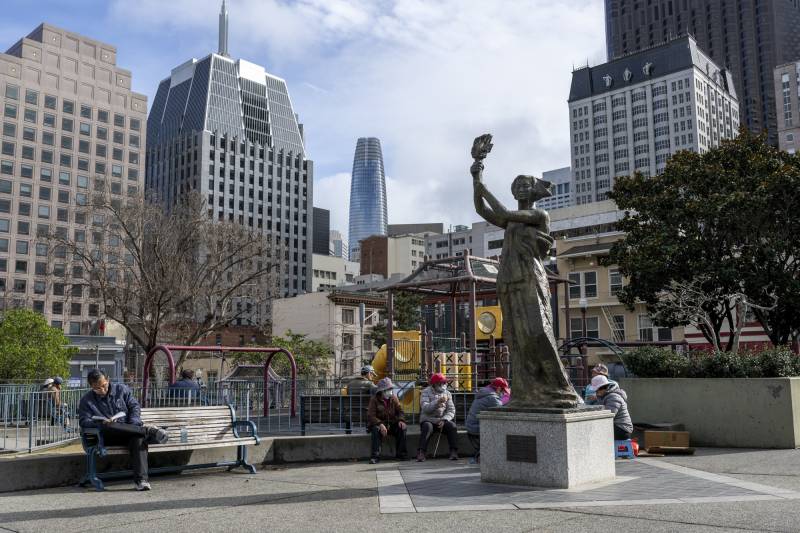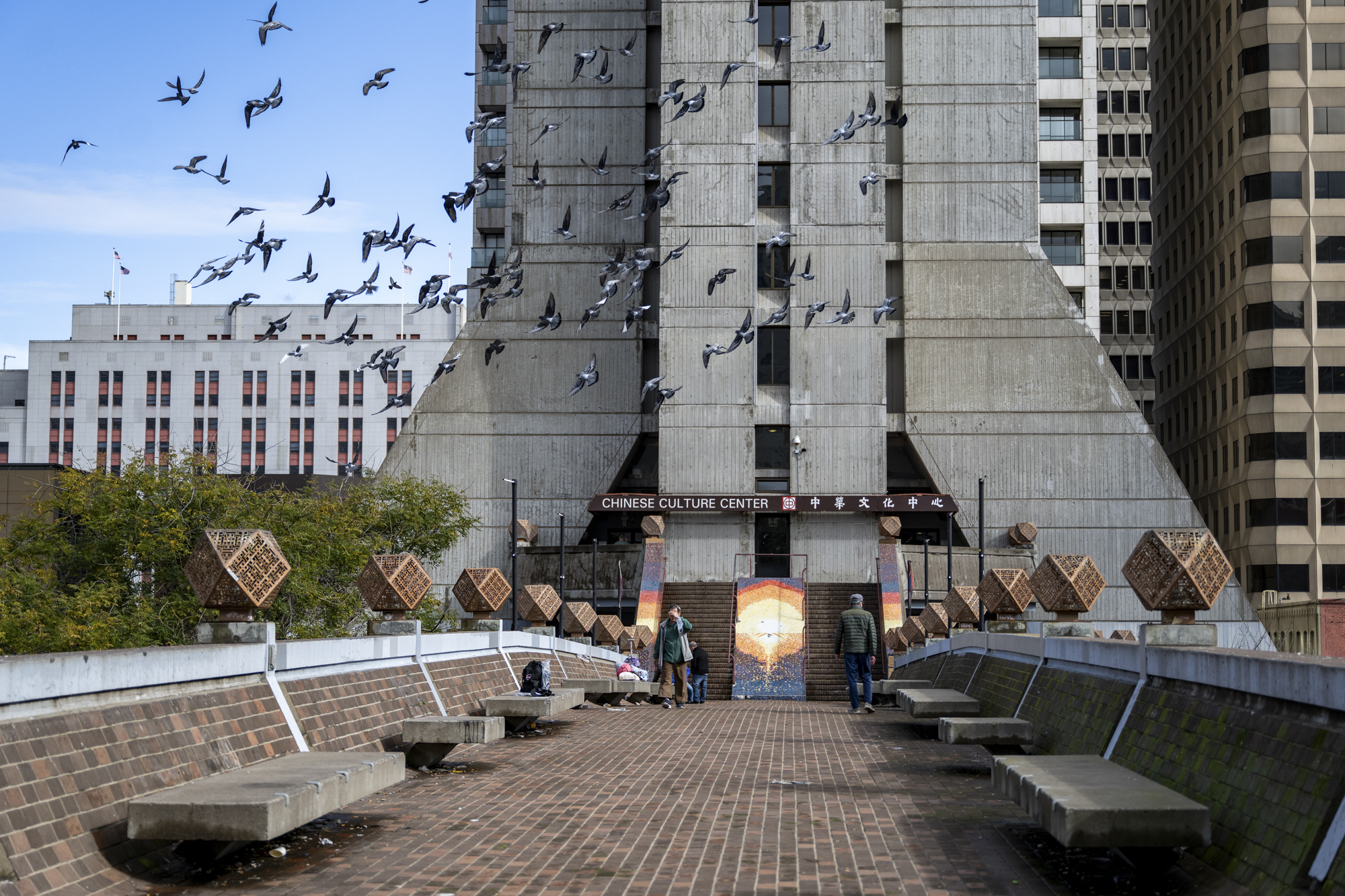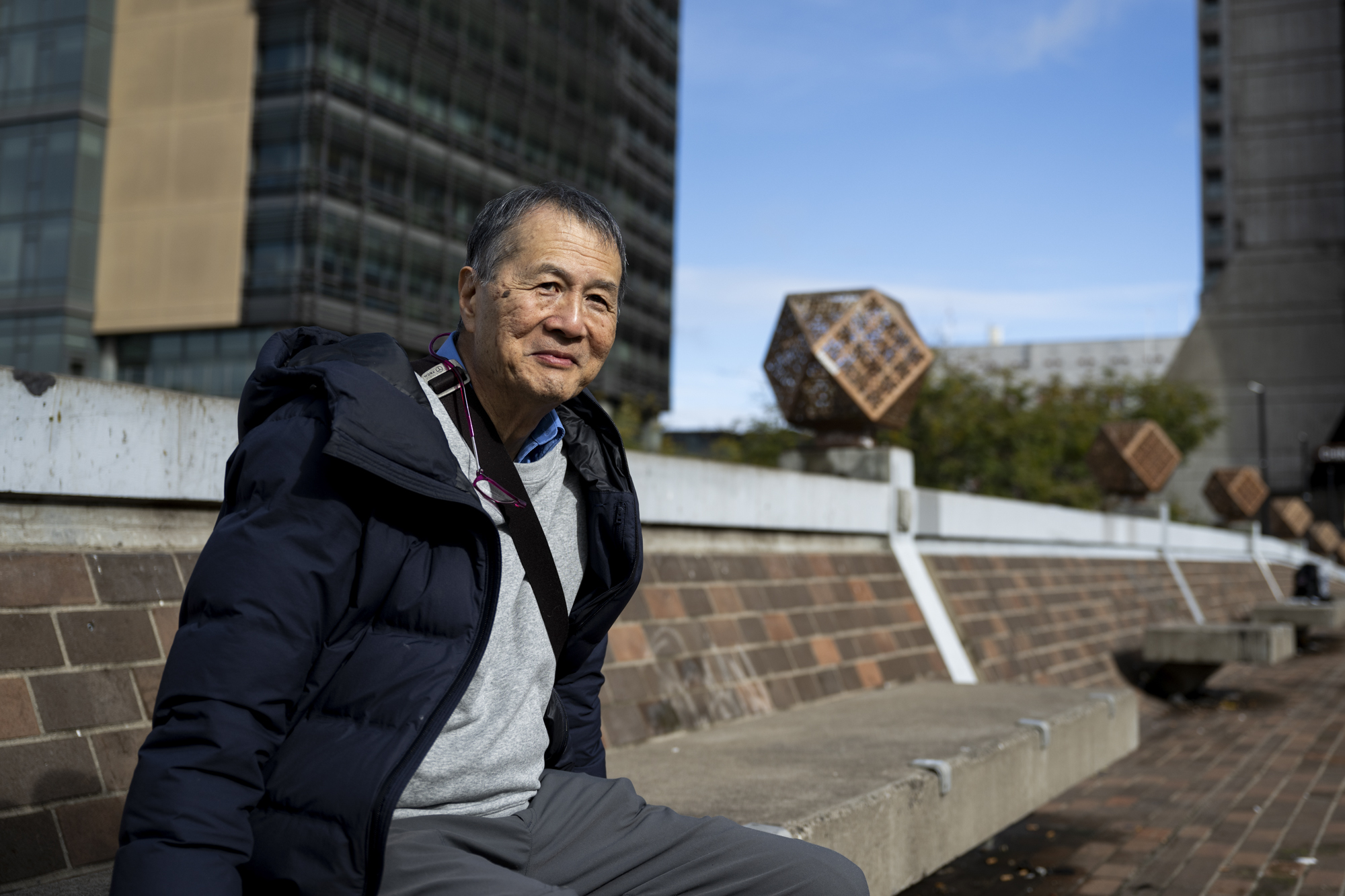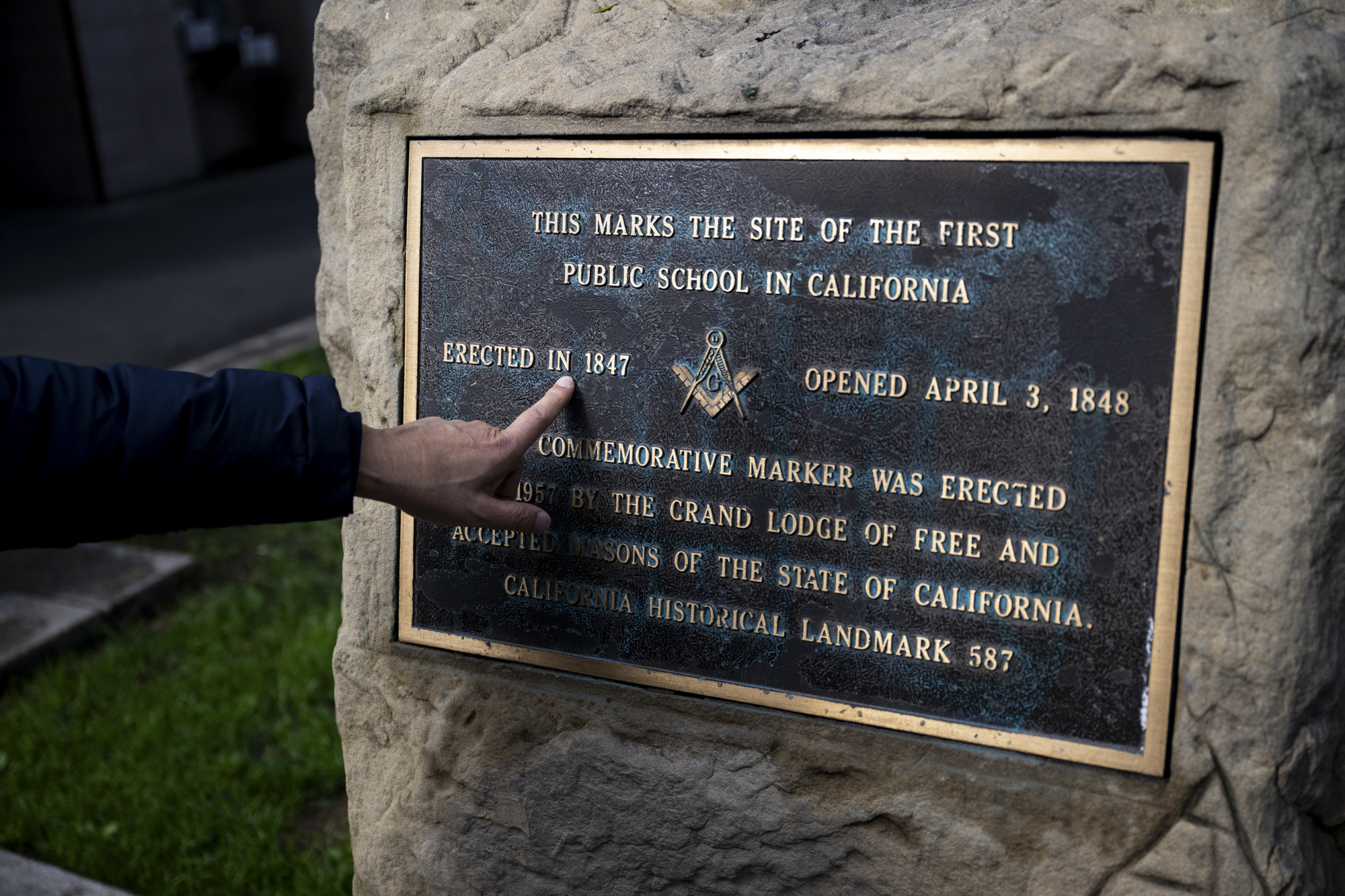SF Chinatown Weighs in on Controversial Monuments in Portsmouth Square (original) (raw)
upper waypoint
Jan 25
Failed to save article
Please try again

People sit near the Goddess of Democracy statue in Portsmouth Square in San Francisco's Chinatown neighborhood on Jan. 22, 2024. (Beth LaBerge/KQED)
Portsmouth Square, a one-block plaza at the heart of San Francisco’s historic Chinatown, is slated to undergo a major facelift.
The project is nearly a decade in the making. But before breaking ground, the city must decide what to do with nearly a dozen controversial public artworks, monuments and plaques currently at the park.
Reconsidering, contextualizing or outright removing public artwork that can represent different things to different people is not a simple process. But it is increasingly necessary, according to community members and the city’s public art curators.
“We’re in a moment of work, doing deep work with the community to understand what they want and what makes sense for the park,” said Allison Cummings, senior registrar for the city’s civic art collection. “Things are moving all over the palace in the park, and nothing will be in the same place that it’s in now. What is the story that’s going to be told?”
Protest and public art
Colloquially known as the “living room” of one of the country’s oldest Chinatowns, Portsmouth Square is recognized as the city’s first park — originally called Plaza de Yerba Buena — established while California was still part of Mexico.
Since then, it’s become a gathering place and geographic symbol for the Chinatown community. On any given day, it’s bustling with people headed to nearby transit lines, huddled playing cards and those looking for a reprieve from dense housing framing the park.

People fill Portsmouth Square in San Francisco’s Chinatown neighborhood on Jan. 22, 2024. (Beth LaBerge/KQED)
“This is the birthplace of San Francisco, and it’s the living room for Chinatown. Most of the people you see here live in Chinatown,” Chinatown expert and historian David Lei said. “Generations of Chinese have started out this way, as poor immigrants, and here, you can put a roof over you and your family’s head. The purpose is to allow people to have a chance.”
Reckonings over controversial public art and monuments took off across the Bay Area amid nationwide protests against police brutality in 2020 — after a Minneapolis police officer killed George Floyd. The discussions led to the removal of statues like the one of Thomas Fallon, a former San José mayor, who played a role in the U.S. annexation of California.
In San Francisco, activists toppled and vandalized multiple statues in 2020 that critics said celebrated racist and colonialist histories. That prompted the city to remove a 12-foot bronze statue of Christopher Columbus the day before protestors had planned to pull it down. Mayor London Breed then directed the Arts Commission to review its public art collection and refine processes around monuments and memorials.
Last year, San Francisco’s Art Commission updated its procedures for reviewing public artwork that may uphold racist, colonialist or other harmful narratives. Also, in 2023, the city received a $3 million grant to implement those new recommendations, starting with an equity audit of the current monuments and memorials in the city’s Civic Art Collection later this year and community outreach.
Representation as history
As the Columbus statue now sits in storage and awaits its public review, three pieces at Portsmouth Square are in the very early stages of the updated review process. Those are the Goddess of Democracy monument, a monument to Scottish novelist Robert Louis Stevenson, and a zodiac sculpture on the children’s playground.
“There’s arguably no artwork in Portsmouth Square that actually commemorates Asian American history,” said Hoi Leung, curator and deputy director of the Chinese Culture Center. She added that no current artwork at the park is by artists of Asian descent, either.

Birds fly above a pedestrian bridge connecting a Hilton to Portsmouth Square in San Francisco’s Chinatown neighborhood on Jan. 22, 2024. (Beth LaBerge/KQED)
Over the last year, the Chinese Culture Center of San Francisco, the Chinatown Community Development Center, the Manilatown Heritage Foundation, and other community organizations, gathered residents and historians to discuss what type of art and interpretation they would like to see to increase public education and understanding about the park and its history.
San Francisco Arts Commission, Planning Department and Recreation and Parks oversee different elements of the redesign. Their next community feedback meeting is on Jan. 30 at 808 Kearny St. in room 402.
At the meetings, Leung said, community members shared that monuments in the park today do little to represent the historical or contemporary contributions and lived experiences of Chinese or Asian Americans.
The Robert Louis Stevenson monument, for example, felt out of touch with some locals who attended one of the recent feedback meetings. The Treasure Island author only briefly stayed in the city and had little to do with the Chinatown community directly.
“There were a lot of vocal opinions about how we have to remove the school monument because it’s racist, and Robert Louis Stevenson had nothing to do with Chinatown. A lot of those comments,” Leung told KQED.
A stone monument honoring the state’s first public schoolhouse that opened at the site of the park in 1848 also exemplifies the frustration some park-goers have. That’s because the school did not allow students of Asian descent to enroll, and many Chinese immigrants in the neighborhood were excluded from any opportunities the school provided.
More than a dozen community members said at a feedback session in October that they would like to see the schoolhouse monument removed because it upholds racist narratives by excluding information on how Chinese students were barred from attending the school. Some said they would rather see artwork depicting the story of segregated Chinese schools and more history of the Chinese Exclusion Act.
But opinions differ.
Lei said he would “make a fuss” if the entire statue were removed.

Historian David Lei sits on a pedestrian bridge connecting a Hilton to Portsmouth Square in San Francisco’s Chinatown neighborhood on Jan. 22, 2024. (Beth LaBerge/KQED)
“A lot of people say, ‘Well, there’s a whole history of [Chinese immigrants] not being able to go,’” Lei said. “They only hear part of it, but there is so much to say.”
The monument needs more historical context, he said, but removing the piece completely could also overlook some important history about the school, which was founded by William Leidesdorff — an affluent Black and Jewish man and one of the earliest founders of the city — who is also left off the plaque.
“This is such an important opportunity to actually empower the community’s voice. Whether it’s ‘remove’ or ‘not remove.’ The point is to give agency to the community to have a voice during that process,” said Jenny Leung, executive director of the Chinese Culture Center. “So often, it’s just about removing pieces or putting them right back where they were. But there are ways to make room for these stories.”
Hoi Leung added that the feedback meetings are a chance for the community to finally weigh in on what art and interpretation at the park can look like moving forward.
“This is a museum without walls,” she said. “We hope that people who care about this come out and add to the pool of endless stories that this park can be a repository for.”
Art for future generations
Pieces in Portsmouth Square won’t be the first civic artwork to undergo the city’s revamped review process. Recently, the Arts Commission approved the removal of the bust of former mayor James Phelan, who advocated for Chinese exclusion. The city plans to replace the piece with a similar bronze bust on a sandstone plinth of Ed Lee, the city’s first Asian American mayor, who died in 2017.
Lei, the historian, said Portsmouth Square could integrate technology like QR codes to create more didactic educational experiences and go beyond a physical plaque’s limited word count. That, he said, could be used to tell stories about the historic buildings that flank Portsmouth Square, some of which were the site of former legal offices that handled cases that have shaped the American fabric, like Tape v. Hurley.

Historian David Lei points to a school house memorial plaque in Portsmouth Square in San Francisco’s Chinatown neighborhood on Jan. 22, 2024. (Beth LaBerge/KQED)
Years before the landmark ruling of Brown v. Board of Education, members of San Francisco’s Chinatown community fought for Mamie Tape, a Chinese American who was barred from attending a San Francisco public school because of her ethnic background. Her family successfully challenged the school’s decision and won in 1885.
But new artwork for Portsmouth Square is not only about sharing new narratives; it’s about highlighting contemporary art and activism that’s exploding in the neighborhood today.
The site was a center for activism at the height of anti-Asian attacks during the pandemic — and a center for healing across generations.
Portsmouth Square’s redevelopment will also coincide with a full renovation of the adjacent brick-and-mortar space run by the Chinatown Media & Arts Collaborative, a multidisciplinary, multiracial art and cultural hub founded in 2017.
“We’re thinking about what we want to leave for the next generation as well,” Hoi Leung said. “What’s critical about this moment is that there is a reckoning for needing to reexamine these monuments and commemoration — and Chinatown should fully participate in it.”
lower waypoint
To learn more about how we use your information, please read our privacy policy.
Signed up.
next waypoint